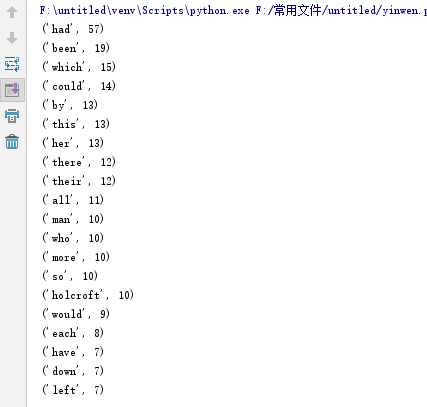一、列表,元组,字典,集合分别如何增删改查及遍历
1、列表
1)增
- append()方法:在列表的末尾增加一个元素
- insert()方法:在列表指定的位置上增加一个元素
- extend()方法:可迭代,分解成元素添加在末尾
2)删
- pop()方法: 按照下标索引删除指定的值
- remove()方法:按元素删除指定的值
- del:删除列表、也可以进行切片删除
2、元组
- 元组不允许修改以及单个删除元素
3、字典
1)增
- dict[key]=value 通过赋值的方法增加元素
2)删
- del dict[key] 删除单一元素,通过key来指定删除
- dict.pop(key) 删除单一元素,通过key来指定删除
3)改
- dict[key]=value 通过对已有的key重新赋值的方法修改
4)查
- dict[key] 通过key访问value值
4、集合
1)增
- add()方法:增加一个元素
2)删
- remove()和pop()方法:删除集合中一个元素
二、总结列表,元组,字典,集合的联系与区别。参考以下几个方面:
- 括号
- 有序无序
- 可变不可变
- 重复不可重复
- 存储与查找方式
联系与区别如下:
1、列表的括号是"[ ]" ,元组的括号是”( )“,字典的括号和集合的括号都是”{ }“;
2、列表与元组都为有序序列,字典与集合为无序序列;
3、列表、字典、集合属于可变序列,而元组属于不可变序列;
4、列表和元组允许重复,而字典和集合不允许重复;
5、
列表以值的方式存储为值,可通过索引查找;
元组以值的方式存储为值,可通过索引查找;
字典以键值对的方式存储为值,一般通过键查找;
集合以值的方式存储为值,可以通过set()来将序列和字典转换为集合。
三、词频统计
- 1.下载一长篇小说,存成utf-8编码的文本文件 file
- 2.通过文件读取字符串 str
- 3.对文本进行预处理
- 4.分解提取单词 list
- 5.单词计数字典 set , dict
- 6.按词频排序 list.sort(key=lambda),turple
- 7.排除语法型词汇,代词、冠词、连词等无语义词
- 自定义停用词表
- 或用stops.txt
- 8.输出TOP(20)
- 9.可视化:词云
排序好的单词列表word保存成csv文件
import pandas as pd
pd.DataFrame(data=word).to_csv('big.csv',encoding='utf-8')
线上工具生成词云:
https://wordart.com/create
词频统计代码如下:
import pandas as pd mum = {'it', 'if', 'the', 'at', 'for', 'on', 'and', 'in', 'to', 'of', 'a', 'was', 'be', 'were', 'in', 'about', 'from', 'with', 'without', 'an', 'one', 'another', 'others', 'that', 'they', 'himself', 'itself', 'themselves', 'if', 'when', 'before', 'though', 'although', 'while', 'as', 'as long as', 'i', 'he', 'him', 'she', 'out', 'is', 's', 'no', 'not', 'you', 'me', 'his', 'but'} def getsong(): file=open("F://xiaoshuo.txt", "r") song=file.read().lower() ch=",.!()" for c in ch: song = song.replace(c,'') return song wordlist=getsong().split() wordset=set(wordlist) - mum wordict={} for w in wordset: wordict[w] = wordlist.count(w) wordsort=list(wordict.items()) wordsort.sort(key= lambda x:x[1],reverse=True) '''输出top20''' for i in range(20): print(wordsort[i]) '''保存为csv文件''' pd.DataFrame(data=wordsort).to_csv(r'F: est.csv',encoding='utf-8')
下面是xiaoshuo.txt:

运行截图如下:
控制台输出:

可视化词云:
